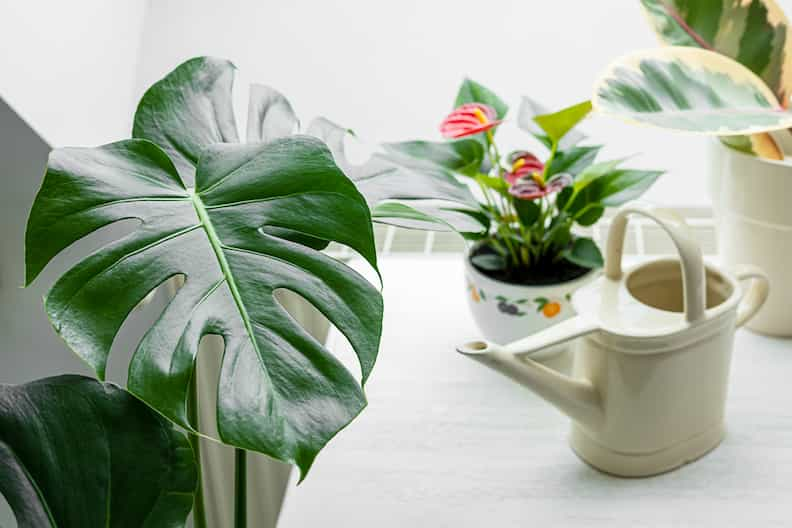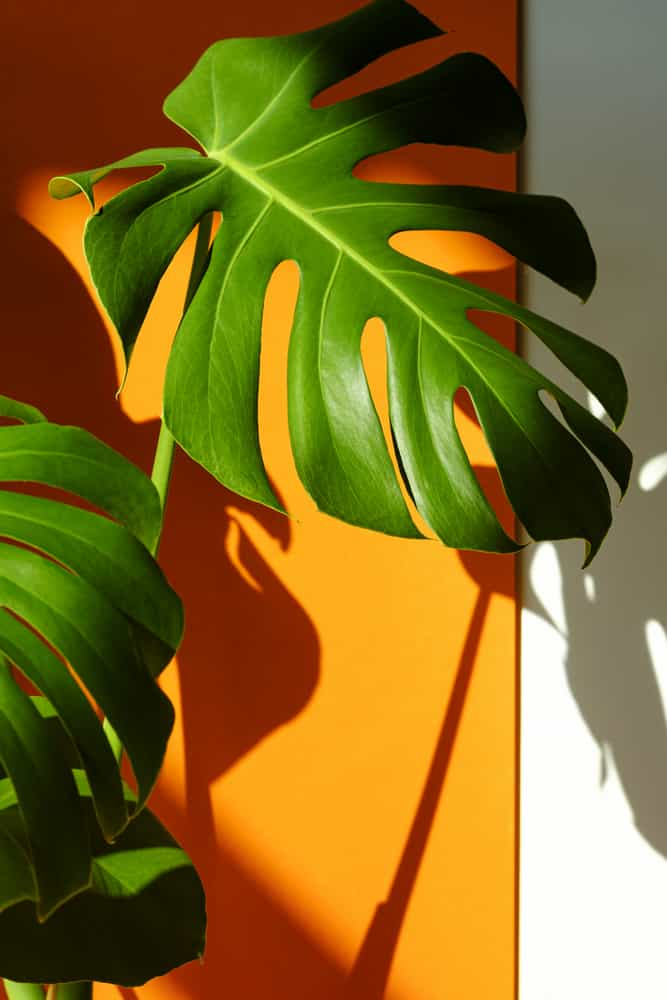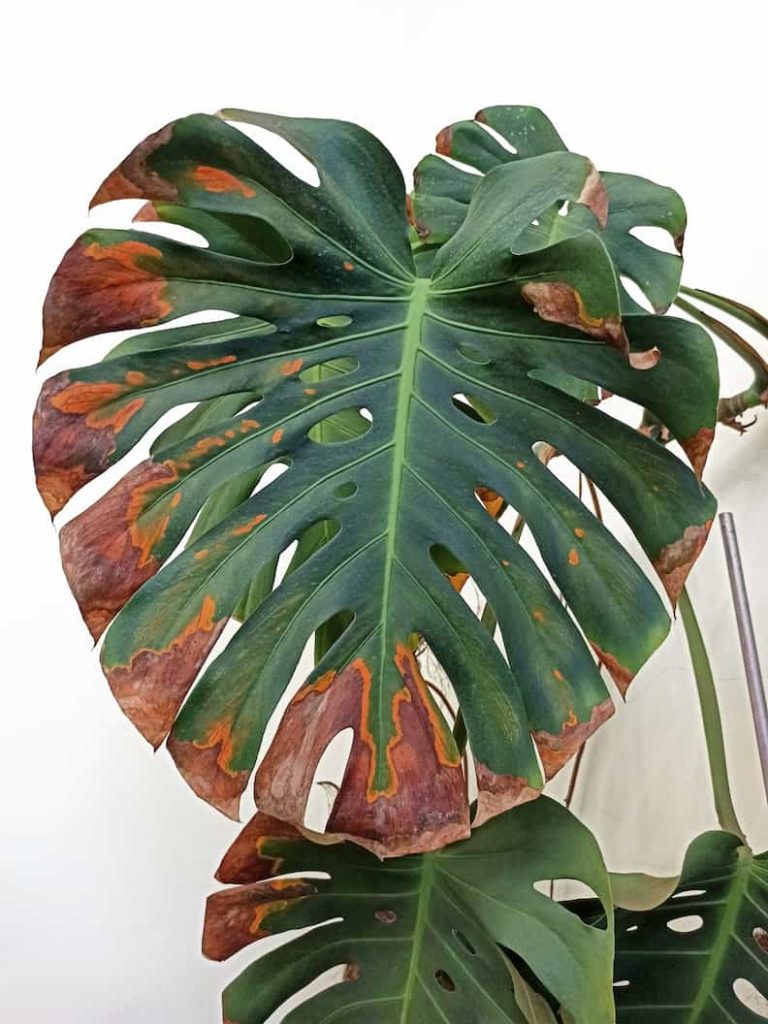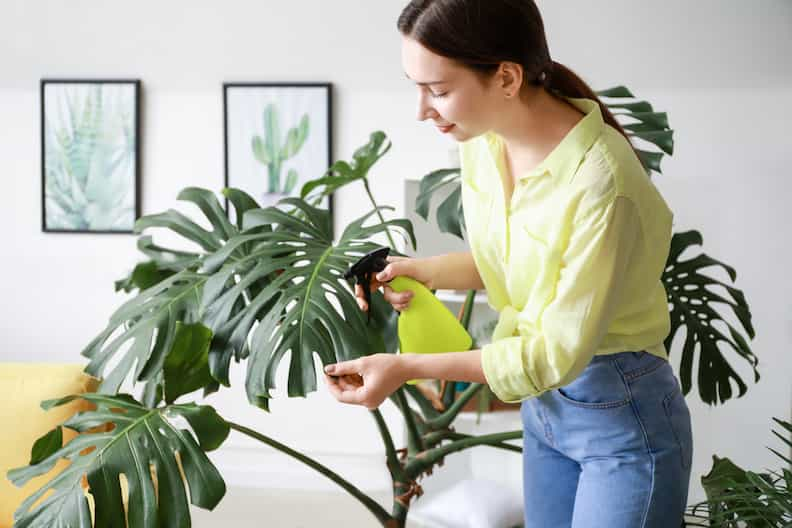Monstera plants are tropical climbing vines from the rainforests of Central and South America. As such they prefer humid conditions and moist soil that drains well. But figuring out how often to water a Monstera plant to reach that ideal moisture level isn’t a cut and dry (…no pun intended!) process.
After all, many factors affect a Monstera plant’s need for water. As a general rule, you need to water your Monstera plant when the soil feels dry 1 to 2 inches below the surface of the soil.
There are, however, some other things you should keep in mind to make sure your plant is getting just the right amount of water, especially to avoid any issues that can arise from either underwatering or overwatering your Monstera.
Here are some guidelines to follow to determine when your Monstera plant should be watered.

Table of Contents
How often to water Monstera
You should water your Monstera around once a week, although the exact timing will depend on the growing conditions, time of year, and the size of the plant’s pot. In particular, you should wait until the top one to two inches of soil are dry before watering your Monstera.
Consider the factors below when deciding how often your Monstera plant needs to be watered.
Seasons and growth rate
Monstera plants get a burst of growth in the spring and continue to grow rapidly all summer. During the warmer months, they need frequent watering to keep up with their demand for water and nutrients. They may need to be watered once a week (or more) to keep up with their rapid growth.
When fall arrives, Monstera plants go dormant to rest from the long season of growing. Dormancy lasts all winter. When the plants are dormant new growth stops and the plant uses its energy to maintain itself through the winter.
This means that, throughout the cooler months, the need for water decreases. As such, your Monstera plant will need less frequent watering in the fall and winter. In fact, it may be happy with watering every 10 to 14 days in the fall and winter.
Pot size
The size of the plant pot matters, too. A large pot, especially one that is too big for the plant, can hold more water in the soil than a small pot can. It takes longer for the soil in a large pot to dry, while a small pot may dry quickly. As a rule, Monsteras grown in a small pot require more frequent watering than those in large pots.
But this can be deceiving, too, as the size of the plant and its root system comes into play with watering, too. A large Monstera plant with a root system that fills the pot (regardless of the pot size) will dry out faster than a Monstera plant growing in a pot that is too large for the root system as excess soil holds more moisture and takes longer to dry.

Type of pot
The type of plant pot you choose can affect how often you need to water your plant – and, in fact, your own habits can really help you to determine the best pot for your Monstera. Porous pots like terracotta and unglazed ceramic can wick water away from the soil and cause the soil to dry quickly, meaning more frequent waterings.
Non-porous pots like plastic or glazed ceramic and terracotta help to hold moisture in. These pots may keep the soil moist for longer, decreasing how often you need to water your plants.
Temperature and humidity
If your Monstera plant is sitting near a sunny window where temperatures rise dramatically from the afternoon sun, the soil in the pot may dry quickly. This, in turn, could leave your Monstera plant begging for a drink.
Hot, dry air also tends to dry out the soil. On the other hand, Monstera plants love humidity and when grown in humid conditions, will dry out more slowly and may need less frequent watering.
The air temperature and humidity level near your Monstera plant can play a significant role in how slowly or quickly the soil dries out. But that’s not the only reason Monsteras may need more water in warmer temperatures.

Plants draw water from the soil and carry it to all parts of the plant to perform photosynthesis and make energy for the plant. In the process, plants release water vapor into the air through tiny pores (called stoma) on the undersides of their leaves during transpiration, the equivalent of human respiration.
Warm temperatures cause the stoma to open thereby releasing more moisture into the air. This increases the demand for water in the soil and causes the soil to dry more quickly.
Soil type
The best soil for Monstera plants is rich and well-draining and needs a good Monstera or aroid soil mix to flourish. Dense soils like all-purpose potting soil are too heavy for tropical plants. Heavy soil drains poorly, keeping the soil moist for too long.
A Monstera plant growing in poorly draining soil needs less frequent watering than one grown in well-drained soil.
Heavy soil can also lead to overwatering and nasty diseases like root rot in Monstera. If your Monstera plant is growing in heavy soil, or the soil does not drain well, it is wise to monitor it closely or repot your Monstera with fresh potting mix.
FYI: As an alternative option, you can grow your Monstera in water, avoiding any sort of consideration of which soil to use – not to mention avoiding the question of how often to water your Monstera as the answer is: never!
How often to water Monstera in summer?
During the summer, your Monstera grows quickly and needs lots of water and nutrients to create the energy needed to grow. It also increases its rate of transpiration, releasing more water vapor into the air. This causes an increased demand for water and so your Monstera may need to be watered once or twice a week in the summer.
And that’s just for indoor Monstera. If you put your Monstera outside, like on a balcony, it may even need to be watered every day during hot, dry spells.
How often to water Monstera in winter?
You should aim to water your Monstera every two weeks in winter, as it can take that long – if not longer – for the soil to dry sufficiently to require more water. This is because, like other houseplants, the Monstera does not actively grow in winter and so needs less water to stay alive.
That is, Monstera plants go through a period of dormancy in the winter where new growth slows down or stops altogether. During this time, there is less demand for water as the plant is not actively growing.
As such, during the winter, your Monstera may go two weeks before it dries out enough, although you may even find this extending to three weeks if your plant’s soil is really holding on to its moisture from the last watering session.
How often to water Monstera cutting
Monstera cuttings can be rooted in a vase or glass of water and can even be grown in water on the windowsill if they are given proper care. Change the water in your Monstera’s vase every 4 to 5 days or whenever it becomes discolored or looks cloudy.
Changing the water regularly gives your cuttings an ample supply of oxygen to the roots and prevents stagnation. In addition, in terms of the placement of your Monstera cutting in your home, make sure they are not subjected to the direct rays of the afternoon sun, as this is well beyond the light requirements of a Monstera.

How do I know if my Monstera needs water?
Your Monstera plant will let you know when it needs water with some obvious signs your Monstera needs water.
1. Wilting or drooping leaves
Wilting occurs when the roots of the plant cannot absorb enough moisture to maintain the pressure needed in plant cells. It is most often a sign that your plant’s soil is too dry and needs to be watered.
But beware. Wilting and drooping leaves on your Monstera can also be a sign your Monstera plant is overwatered, and the soil is too soggy for the roots to uptake water as they should. Always check the soil to see if it is wet or dry before watering your Monstera plant.
2. Dry soil
Soil that dries out excessively may look crusty and pull away from the sides of the pot. Giving your Monstera plant a quick drink won’t likely solve the problem.
To correct soil that is so dry it has pulled away from the pot, you will need to soak the pot in water until air bubbles stop floating to the top of the water.
3. Curling leaves
When your Monstera plant is starved for water, it may develop curled leaves. At this stage, a good watering typically takes care of the problem. Your Monstera’s leaves will unfurl as they get the moisture they need from the soil.
4. Brown margins on leaves
If curled leaves don’t get your attention, your Monstera’s leaves will begin to turn brown along the edges. They will gradually turn dry and crispy and fall from the plant.
Watering your plant won’t fix the dried leaves, but it will prevent other Monstera leaves from turning brown and curling.

5. Slowed growth
Slowed growth is normal during the fall and winter and isn’t a cause for concern. But if your otherwise healthy Monstera shows slowed or stunted growth during the spring and summer when it should be growing, lack of water may be the reason.
How do you check the moisture level in your Monstera’s soil?
There are two simple ways to check the moisture level in your Monstera’s pot. You can use the finger test or use a moisture meter.
Finger test
The finger test is a simple procedure that relies on your sense of touch to measure the moisture in the soil. Here’s how.
- Insert your finger into the soil in your Monstera plant’s pot to a depth of 1 to 2 inches.
- Observe whether the soil feels dry, slightly moist, or wet.
- Check your finger for traces of soil. If your finger is clean the soil is dry. If you notice traces of soil clinging to your finger, the soil is slightly moist. If your finger is wet and looks a bit muddy with a coating of soil on it, your soil is too wet.
Moisture meter test
A moisture meter is a simple tool with a probe for the soil and a gauge that displays the moisture level in the soil. You can purchase a moisture meter at plant centers and hardware stores for a minimal fee.
- Insert the probe into the soil to the recommended depth. You can measure the moisture an inch or two below the surface, or you can measure the moisture at the root level.
- Wait the appropriate amount of time as directed on the package. Sixty seconds is typical, but your meter may require more or less time for an accurate reading.
- Check the display window for the moisture reading. Moisture meters typically display readings with a needle that moves from dry to moist to wet soil, with the sections highlighted in red, green, and blue. Red means the soil is dry, green means it is moist and blue means the soil is wet.
Your Monstera plant needs to be watered if the soil 1 to 2 inches below the surface is dry and the moisture level at the roots level is slightly moist.
Do Monsteras need a lot of water?
Monsteras don’t need a lot of water, with their needs being similar to other tropical houseplants. Instead, Monstera plants need moist soil that doesn’t dry out completely between waterings, nor do they like overly soggy soil.
Water your Monstera plant to saturate the soil and then let it dry out before you water it again. When the soil feels dry 1 to 2 inches below the surface, it is time to water your Monstera plant.
If you are using a moisture meter to measure the moisture level in the soil you can check the soil at the root level, too. The soil at the root level should not dry out completely.
A reading of slightly moist and the root level and dry 1 to 2 inches below the surface means it is the right time to water your Monstera.
Should I mist my Monstera deliciosa?
While you can mist your Monstera deliciosa, it’s not necessary, especially as you would need to mist the plants several times a day in order to make a noticeable difference in the humidity levels near your plants. Misting the aerial roots and the moss on your pole once a day may be more beneficial, and less time-consuming.
That is, many Monstera lovers mist their Monstera plants every day to raise the humidity level around their plants. While it may provide some benefit to your plants, the Iowa State University Extension explains that the benefits are short-lived.

At the same time, if you have the time and inclination, misting your Monstera several times a day will help keep the humidity level up creating the humid environment Monstera plants love.
In terms of why misting the aerial roots on your Monstera as well as your Monstera’s moss pole may be better, this is because it can help to keep the roots moist and prevent them from drying out. Your Monstera plant depends on healthy aerial roots to help it climb and part of that is ensuring they’re not thirsty.
How often should I mist Monstera?
If your goal is to raise the humidity level around your Monstera plants, you would need to mist your plants multiple times a day. You can mist the aerial roots and the moss on your pole once a day to keep them hydrated and happy.
More effective ways to raise the humidity near your plants is to use a humidifier or pebble trays filled with water. You can also group your plants together to take advantage of the moisture they release during transpiration.
How long can Monstera last without water?
A Monstera should be able to last without water for 7 to 10 days in the summer and 10 to 14 days in the winter. That said, keep in mind that your Monstera plant may need water more frequently, or it may be able to survive a longer period without water, depending on its own individual circumstances.
After all, how long a Monstera plant can last without water is relative. So many factors, such as growing medium, plant size, pot size, and the time of year all affect how long your Monstera plant can go without water.
Final thoughts on how often to water a Monstera
Learning to water your Monstera plant when it needs it instead of relying on a strict watering schedule will help you raise healthy plants that flourish in your home.
Keep in mind that watering needs change throughout the year and that no two plants will need the exact same care. As such, treat your Monstera as an individual and take your cues with the plant to decide when it needs water.
